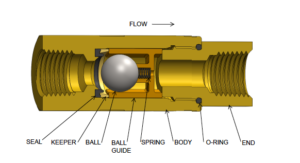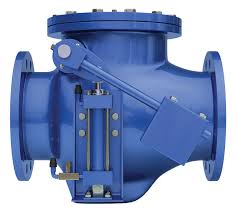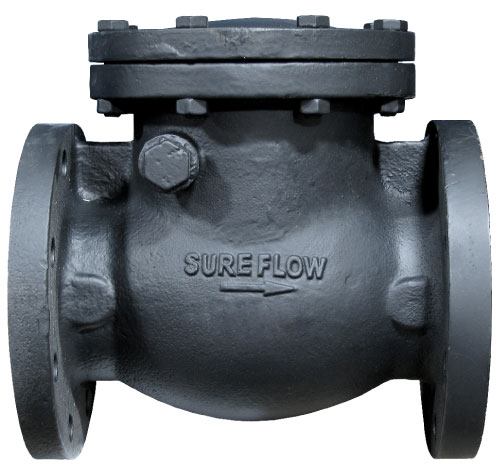Valves
What is a Check Valve?
What is a Check Valve?
A check, clack, non-return, reflux, retention, or single-direction valve is a valve that typically permits liquid (fluid or gas) to move through it in only one direction. Check valves are two-port valves, which means they have two openings in the body, one for liquid to enter and the other for liquid to leave. There are different kinds of check valves utilized in a wide assortment of uses. An important concept of check valves is the cracking pressure, which is the base differential upstream pressure between inlet and outlet at which the valve will work. Regularly the check valve is intended for and can in this way be designed for a specified cracking pressure. Check out available valves on MFGPartsPlus here. Or learn more about the products from Tokyo Keiki (Tokimec) here.
Terminology:
Cracking Pressure — Refers to the base pressure differential required between the inlet and outlet of the valve at which the principal sign of stream happens (constant flow of bubbles). Cracking pressure is also known as unseating head or opening pressure.
Reseal Pressure — Refers to the pressure differential between the inlet and outlet of the valve during the end procedure of the check valve, at which there is no visible leak rate. Reseal pressure is otherwise called fixing pressure, seating head, or shutting pressure.
Back Pressure — a weight higher at the outlet of a fitting than that at the delta or a point upstream.
Types of Check Valves:
Ball Check Valve — is a check valve where the end part, the movable part to obstruct the stream, is a ball. In some ball check valves, the ball is spring-stacked to help keep it shut. For those designs without a spring, turn around stream is required to push the ball toward the seat and make a seal.  The inside surface of the fundamental seats of ball check valves are pretty much narrowly decreased to manage the ball into the seat and structure a positive seal when stopping reverse flow. Ball check valves are frequently small, simple, and cheap. They are generally utilized in fluid or gel mini-pump gadget nozzles, shower gadgets, some elastic bulbs for siphoning air, manual air pumps, different siphons, and refillable dispensing syringes. Despite the fact that the balls are frequently made of metal, they can be made of different materials; in some specific cases out of exceptionally solid or dormant materials, for example, sapphire. High pressure HPLC pumps and comparable applications generally use small inlet and outlet ball check valves with balls of artificial ruby and seats made of sapphire. After prolonged use, check valves can wear or the seat can develop a split, requiring substitution. Accordingly, such valves are made to be replaceable. There are comparable check valves where the plate isn’t a ball, yet some other shape, for example, a poppet energized by a spring. Ball check valves ought not be mistaken for ball valves, which is an alternate sort of valve where a ball goes about as a controllable rotor to stop or direct flow.
The inside surface of the fundamental seats of ball check valves are pretty much narrowly decreased to manage the ball into the seat and structure a positive seal when stopping reverse flow. Ball check valves are frequently small, simple, and cheap. They are generally utilized in fluid or gel mini-pump gadget nozzles, shower gadgets, some elastic bulbs for siphoning air, manual air pumps, different siphons, and refillable dispensing syringes. Despite the fact that the balls are frequently made of metal, they can be made of different materials; in some specific cases out of exceptionally solid or dormant materials, for example, sapphire. High pressure HPLC pumps and comparable applications generally use small inlet and outlet ball check valves with balls of artificial ruby and seats made of sapphire. After prolonged use, check valves can wear or the seat can develop a split, requiring substitution. Accordingly, such valves are made to be replaceable. There are comparable check valves where the plate isn’t a ball, yet some other shape, for example, a poppet energized by a spring. Ball check valves ought not be mistaken for ball valves, which is an alternate sort of valve where a ball goes about as a controllable rotor to stop or direct flow.
Diaphragm Check Valve — a check valve that utilizes a diaphragm situated to make a normally-closed valve. Pressure on the upstream side must be more prominent than the weight on the downstream side by a specific sum, known as the pressure differential, for the check valve to open permitting flow. When positive pressure stops, the diaphragm consequently flexes back to its original shut position.
Swing Check Valve — a check valve is a check valve where the plate, the versatile part to hinder the stream, swings on a pivot or trunnion, either onto the seat to close turn around stream or off the seat to permit forward stream. The seat opening cross-area might be opposite to the centerline between  the two ports or at a point. In spite of the fact that swing check valves can come in different sizes, huge check valves are regularly swing check valves. A typical issue brought about by swing check valves is known as water hammer. This can happen when the swing check closes and the stream suddenly quits, causing a flood of weight bringing about high velocity shock waves putting enormous pressure on the metals and vibrations in the framework. Undetected, water hammer can burst pumps, valves, and pipes inside the system. The flapper valve in a flush-toilet is a case of this sort of valve. Tank pressure holding it shut is overwhelmed by manual lift of the flapper. It at that point stays open until the tank channels and the flapper falls due to gravity.
the two ports or at a point. In spite of the fact that swing check valves can come in different sizes, huge check valves are regularly swing check valves. A typical issue brought about by swing check valves is known as water hammer. This can happen when the swing check closes and the stream suddenly quits, causing a flood of weight bringing about high velocity shock waves putting enormous pressure on the metals and vibrations in the framework. Undetected, water hammer can burst pumps, valves, and pipes inside the system. The flapper valve in a flush-toilet is a case of this sort of valve. Tank pressure holding it shut is overwhelmed by manual lift of the flapper. It at that point stays open until the tank channels and the flapper falls due to gravity.
Stop-Check Valve — a check valve with override control to stop flow paying little heed to stream direction or pressure. Notwithstanding shutting because of reverse or deficient forward pressure (normal check-valve behavior), it can likewise be intentionally closed by an outer system, thereby preventing any flow regardless of forward pressure.
Lift-Check Valve — a check valve where the plate, at times called a lift, can be lifted up off its seat by higher weight of inlet or upstream liquid to enable stream to the outlet or downstream side. A guide keeps movement of the plate on a vertical line, so the valve can later reseat appropriately. At the point when the pressure is never again higher, gravity or higher downstream pressure will make the circle lower onto its seat, closing the valve to stop reverse flow.
In-Line Check Valve — a check valve that has a spring that will ‘lift’ when there is pressure on the upstream side of the valve. The pressure required on the upstream side of the valve to beat the spring strain is known as the ‘cracking pressure’. At the point when the pressure on the valve becomes less than the cracking pressure, the spring will close the valve to prevent back-flow in the process. Here is a good article from FluidPower World.
Duckbill Check Valve — a check valve where the flow continues through a soft cylinder that protrudes into the downstream side. Back-pressure crumples this cylinder, cutting off flow.

